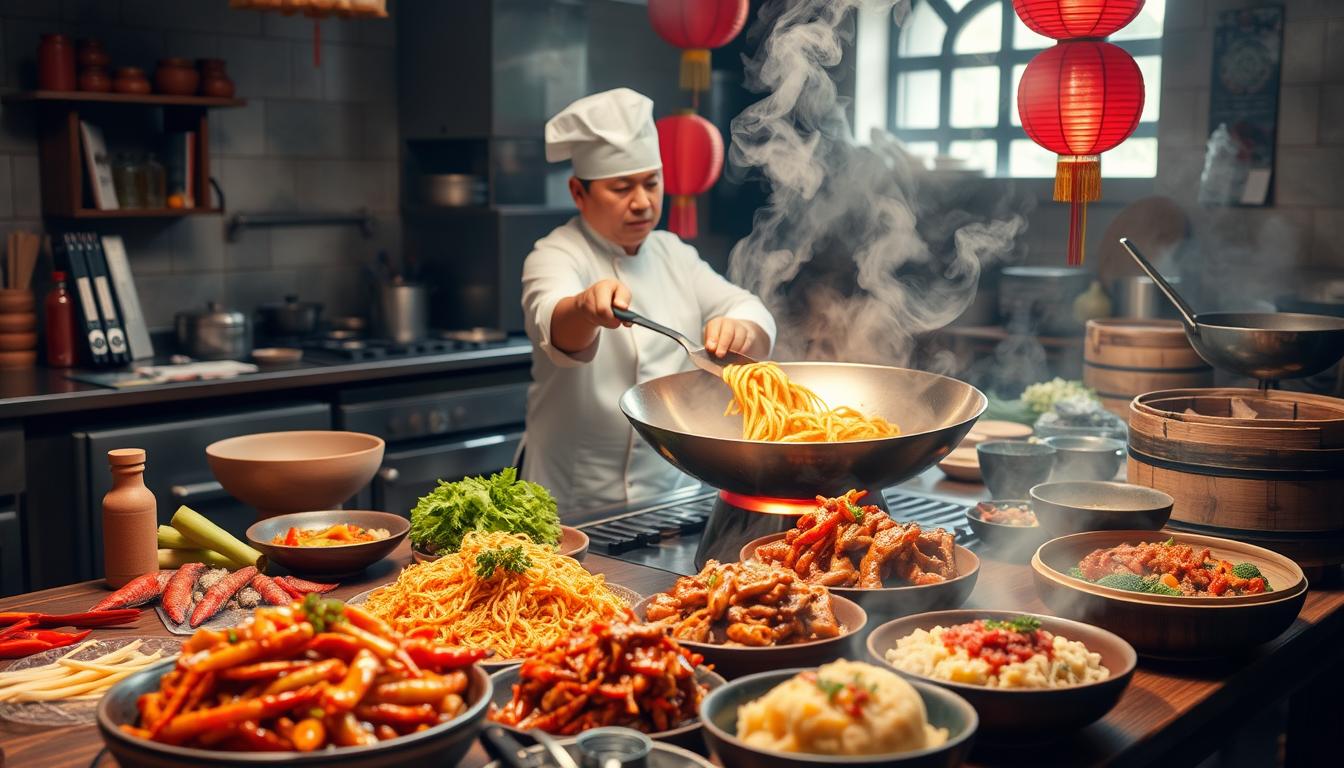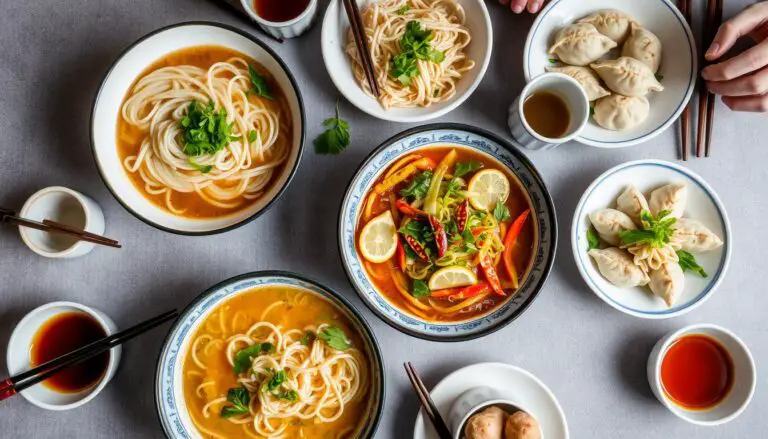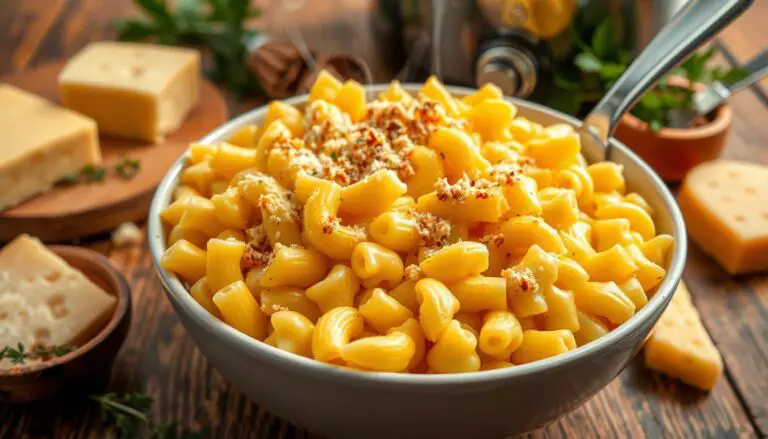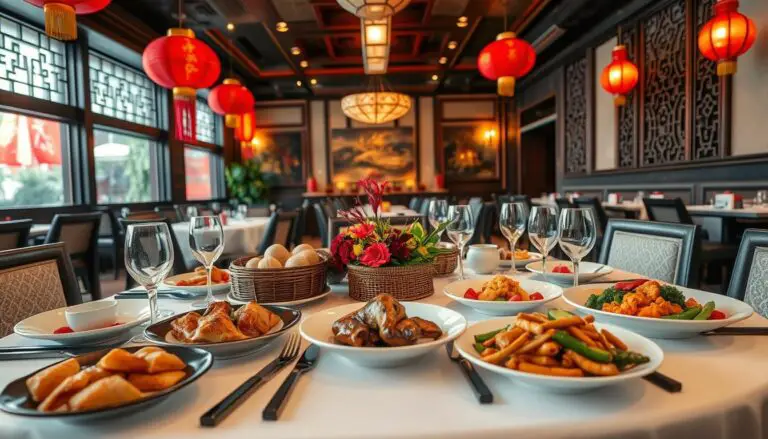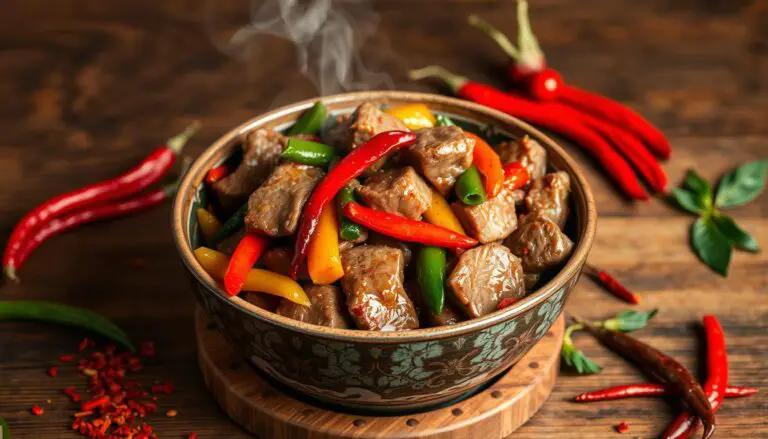Master Authentic Sichuan Cooking Techniques
Ever wondered why Sichuan food is so loved worldwide? It’s known for its bold flavors, from spicy to pungent. This guide will help you learn authentic Sichuan cooking. You’ll discover unique flavors and traditional practices that have lasted for centuries.
By focusing on key ingredients and the true essence of Sichuan cooking, you’ll learn to make amazing dishes. These dishes will show off the boldness of this incredible cuisine.
Key Takeaways
- Sichuan cuisine boasts vast gastronomic diversity, making it a culinary jewel of China.
- Master classic recipes like Kung Pao chicken and mapo tofu to experience Sichuan’s vibrant flavors.
- Utilizing homemade chili oil brings an authentic taste that surpasses store-bought versions.
- Focusing on quality spices and ingredients maximizes flavor and authenticity in Sichuan dishes.
- Understanding core cooking methods enhances the ability to balance flavors and heat levels effectively.
- A well-stocked Sichuan pantry is essential for creating traditional dishes with ease.
- Learning about the art of marinating and preparing meats elevates the overall dining experience.
Introduction to Sichuan Cuisine
Sichuan cuisine is known for its bold and complex flavors. It’s not just about heat. Ingredients like garlic, chili peppers, and Sichuan pepper mix to create a unique taste. This shows the region’s dedication to deep flavors.
The Unique Flavor Profiles of Sichuan
Sichuan’s flavors include seven tastes: sweet, sour, numbing-spicy, spicy, bitter, fragrant, and salty. Chengdu, the capital, is called the “World Cuisine Capital” by UNESCO in 2010. This shows its advanced cooking traditions1.
Key dishes show this variety. They use special techniques and flavors that make your taste buds dance. Learning about Sichuan’s history helps us understand how these flavors came to be. It’s a story of cultural exchange over centuries.
A Brief History of Sichuan Culinary Traditions
The history of Sichuan’s food is filled with migrations and cultural mix-ups. During the Ming and Qing dynasties, people from Hubei and Jiangxi came. They brought new ways of cooking and ingredients2.
The late Ming dynasty saw the arrival of chili peppers. This changed Sichuan’s taste forever. Past events have shaped the diverse and complex cuisine we love today12.
Must-Have Ingredients for Authentic Sichuan Cooking
To get the unique flavors of Sichuan recipes, you need the right ingredients. Knowing the essential spices and choosing quality ingredients will make your cooking better.
Essential Spices and Condiments
Sichuan cooking relies on special spices and condiments. Sichuan peppercorns give a unique numbing and tingling feeling. They also add a citrusy aroma that makes dishes more complex3.
The erjingtiao chili is loved for its fruity and warm taste. It adds depth to many recipes3. Chili oil, made with a 4-to-1 oil-to-dried-chili ratio, is versatile3. Doubanjiang, made from fava beans and chilis, adds spice and umami flavors3.
Black vinegar adds a sweet, malty flavor, balancing savory dishes. Soy sauce adds salt and umami, essential for taste3.
Choosing Quality Produce and Proteins
Quality produce and proteins are key to authentic Sichuan cuisine. Fresh ingredients like ginger, garlic, and scallions add depth and richness4. Local and seasonal produce reflects Sichuan’s geography and culture4.
Traditional rapeseed oil is common in Sichuan. It enhances flavors with its unique properties3. Choosing quality ingredients is crucial for a meal that pleases the palate and honors culinary heritage.
The Art of Sichuan Cooking Techniques
Sichuan cooking techniques show a rich tradition. They include stir-frying, steaming, and braising. These methods add unique textures and flavors to dishes. Knowing these techniques helps chefs make authentic Sichuan dishes.
Fundamental Cooking Methods Used in Sichuan
In Sichuan cuisine, cooking methods are key to its flavors. Stir-frying cooks quickly, keeping ingredients crisp. Steaming cooks gently, keeping dishes moist and flavorful. Braising cooks slowly, deepening flavors.
Using traditional tools like woks and steamers is important. They help in achieving the success of dishes.
Balancing Flavors and Managing Heat Levels
Balancing flavors is essential in Sichuan cuisine. Chefs use chili peppers and Sichuan peppercorns to create harmony. Managing spice levels is crucial to avoid overwhelming the taste buds.
Many diners think Sichuan pepper’s tingling is an allergic reaction. But it’s just a unique flavor. Since 2005, quality Sichuan peppercorns have been easier to find. This has improved the taste of authentic Sichuan dishes56..
Setting Up Your Sichuan Pantry
A well-stocked pantry is key for authentic Sichuan cooking. Knowing the sichuan pantry essentials can make cooking easier and more fun. Soy sauce, chili oil, and vinegars are must-haves for Sichuan’s unique flavors.
Building a Well-Stocked Kitchen for Sichuan Cooking
When stocking a sichuan kitchen, aim for a variety of flavors. You’ll need:
- Light and dark soy sauces for different tastes. Light adds umami, while dark adds color.
- Oyster sauce for depth and richness, used in many Sichuan dishes.
- Rice wine and vinegar for marinating and braising, boosting meal flavors.
- Shiitake mushrooms for extra flavor in stir-fries and braises.
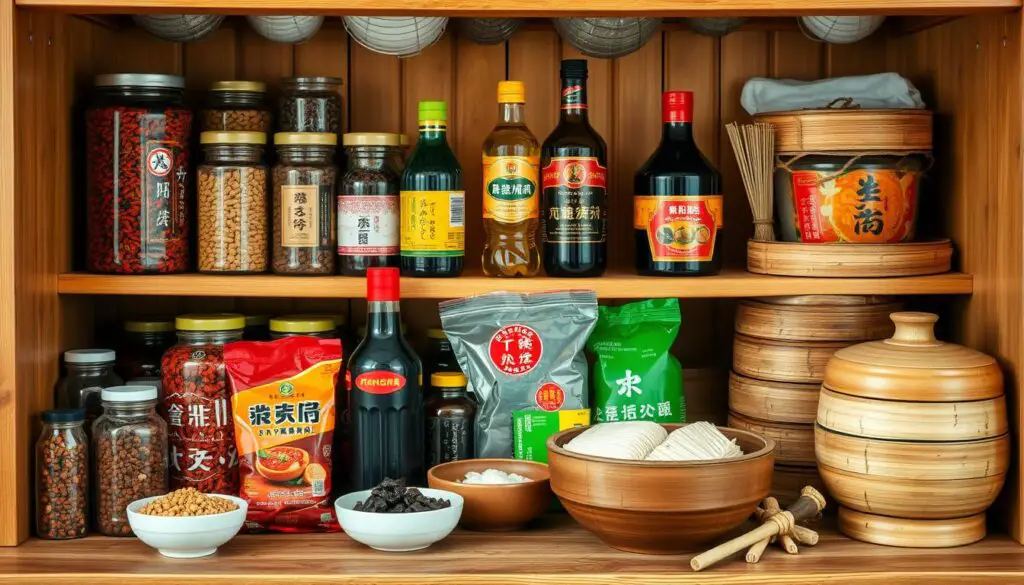
Substitutions for Hard-to-Find Ingredients
For hard-to-find items, knowing substitutions for sichuan ingredients is helpful. Here are some options:
- White vinegar with a bit of soy sauce can replace rice vinegar.
- Preserved mustard greens or pickled veggies can stand in for yacai.
- Fresh chili flakes can substitute Sichuan peppercorns for heat, though it won’t be the same.
Using these substitutions for sichuan ingredients lets home cooks enjoy Sichuan flavors without giving up their culinary journey78.
Perpetual Chinese Master Stock (卤水)
Making a master stock in Sichuan cooking is an art and tradition. It makes dishes more flavorful. This broth gets better with each use, perfect for various meats.
The Benefits of Master Stock in Sichuan Cooking
Master stock’s main advantage is its concentrated flavor. It adds depth to dishes. Plus, it can be frozen forever, making cooking easier and flavors consistent9.
Ingredients and Method for Creating Lushui
To make lushui, you need certain ingredients. These include:
- Molten rock sugar for its dark color.
- Aromatic spices like ginger, garlic, and star anise.
- Fresh herbs and quality meats for taste.
The way you prepare it is just as important. Here’s how to brine:
- Boil water and spices together.
- Cool the stock and soak your meats in it.
- Brine a whole young chicken for 60-90 minutes. Pork belly needs 40 minutes to brine and 120 minutes to soak9.
Here are some tips for keeping lushui:
- Add a splash of baijiu or vodka for more aroma.
- Use boiled brine within two days if stored with the lid on.
- Uncovered brine in the fridge lasts 3-5 days if cooled and sealed9.
Lushui doesn’t use soy sauce. It gets its richness from aromatics and umami10.
Signature Sichuan Recipes to Try at Home
Exploring Sichuan cuisine at home opens a world of bold flavors and textures. Many signature dishes are easy to make. This lets home cooks enjoy the essence of this exciting culinary tradition. Two beloved recipes are the kung pao chicken recipe and the vegetarian favorite, Mapo Tofu. Also, mastering the dan dan noodles recipe is essential, as it captures the spicy and savory notes of Sichuan food.
Classic Dishes: Kung Pao Chicken and Mapo Tofu
The kung pao chicken recipe uses skinless and boneless chicken breast cut into 1-inch cubes. It’s quick and satisfying, ready in just 15 minutes. The author’s family loves it so much, they crave it every week11.
The Szechuan sauce is a mix of soy sauce, rice vinegar, hoisin sauce, brown sugar, and cornstarch. It provides the perfect balance of flavors that define Sichuan cooking. You can customize it by adding more vegetables like mushrooms or broccoli, making it more vibrant and nutritious.
Delicious Sichuan Noodles: Dan Dan Noodles Recipe
The dan dan noodles recipe offers a comforting and spicy dish that’s simple to prepare. Chinese Chili Oil is key for authenticity. Making it at home involves using 3 cups of neutral oil, infused at 225-250°F for optimal flavor12.
Infusing spices for 30 minutes to 1 hour intensifies the taste. Szechuan chili flakes add that distinctive heat. Storing the oil in an airtight container keeps it fresh in the fridge for up to 3 months.
Cooking Sichuan recipes at home invites creativity and exploration. Engage with the historical depth and stunning flavors through these classic dishes. Whether you’re preparing kung pao chicken or perfecting your dan dan noodles, these recipes will enhance your culinary skills and expand your palate. For an additional treat, try the delicious appetizer Fuqi Feipian, which you can learn more about here11.
Exploring Sichuan Spice Usage
Sichuan cuisine is all about vibrant spices. Sichuan peppercorns and chili oil are key for real flavors. They’re crucial for anyone wanting to make authentic Sichuan dishes at home.
The Role of Sichuan Peppercorns and Chili Oil
Sichuan peppercorns add a unique numbing heat to dishes. They pair well with chili oil, adding richness and heat. This mix is essential for authentic Sichuan flavors.
Together, they’re found in many Sichuan recipes. They balance flavors with spicy, sweet, sour, and umami notes. This combination is vital for the taste of Sichuan dishes1314.
Creating Authentic Spice Blends for Flavor Depth
Making your own chili oil and spice blends lets you tailor flavors. Use top-notch Sichuan peppercorns and quality oils like peanut oil. Recipes often include garlic and ginger for extra flavor.
For those who can’t find Sichuan ingredients, there are substitutes. Adjusting spice levels is key. This way, you can make blends that suit your taste and respect Sichuan cooking traditions13
Mastering Sichuan Cooking Secrets
Exploring Sichuan cuisine means learning key techniques. This includes marinating meats and balancing flavors and textures. Using the right sauces, like soy and oyster, adds taste and texture to dishes15.
Techniques for Marinating and Preparing Meats
Marinating is key for Sichuan’s bold flavors. Ingredients like Shaoxing wine and sesame oil add sweetness and depth. Meats need the right marinating time to soak up flavors.
This makes the meat tender and aromatic. Knowing how to marinate different meats, like pork or chicken, is important. It makes the dish better.
Using Aroma and Texture to Enhance Dishes
Stir-frying and steaming are key to Sichuan cooking. These methods keep flavors natural and add complexity. Stir-frying, for example, makes textures pleasing and keeps colors and smells bright.
Deep frying and braising add variety to textures. They create delicious contrasts in every bite.
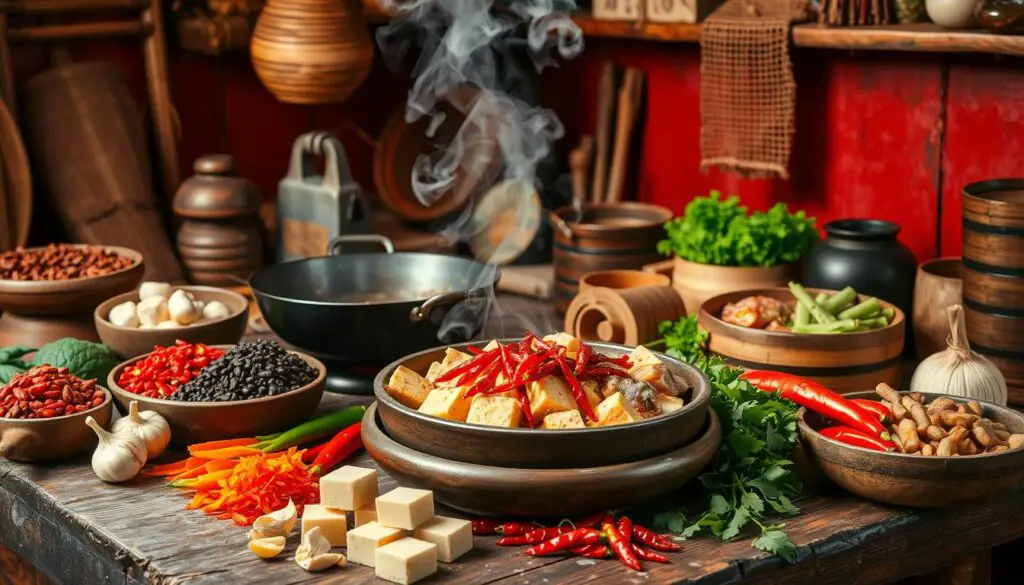
Conclusion
Learning to cook Sichuan dishes is more than just making food. It’s about enjoying the rich flavors and history of this cuisine. Chinese cooking has a long history, over 4,000 years, which has shaped Sichuan’s unique tastes. By mastering key ingredients and techniques, you can make dishes like Mapo Tofu and Kung Pao Chicken. These dishes tell stories of Sichuan’s heritage and innovation16.
Exploring Sichuan cooking means trying new spices and techniques. Every dish you make is a chance to grow your skills and share delicious food with others. This way, you create special moments around the table. As cooking styles change, the love for Sichuan dishes will only grow1718.
This journey into Sichuan cooking is for anyone who loves food. It lets you discover the vibrant tastes and history of this art form. By learning these techniques, you not only improve your cooking but also connect with a culture rich in tradition1617.

